Heredity: An Exploration of Human Traits and Development
VerifiedAdded on 2021/05/31
|16
|3998
|32
Essay
AI Summary
This essay provides a comprehensive overview of heredity, exploring its profound influence on human traits. It begins by defining heredity and its mechanisms, including the role of genes, DNA, and chromosomes in transmitting characteristics from one generation to the next. The essay then delves into the interplay between nature and nurture, examining how both genetic inheritance and environmental factors shape psychological and physiological traits. It discusses key concepts such as the Mendelian laws of inheritance, gene variation, and the impact of the environment on gene expression. Furthermore, the essay explores how heredity contributes to individual differences and influences learning processes, touching upon theories like those of Sigmund Freud, Eric Ericson, and Albert Bandura. Ultimately, the essay underscores the complex and multifaceted nature of heredity and its enduring impact on human development and differentiation. The essay also provides details on the role of the environment in shaping traits and how acquired and inherited traits influence individual differentiation and learning.
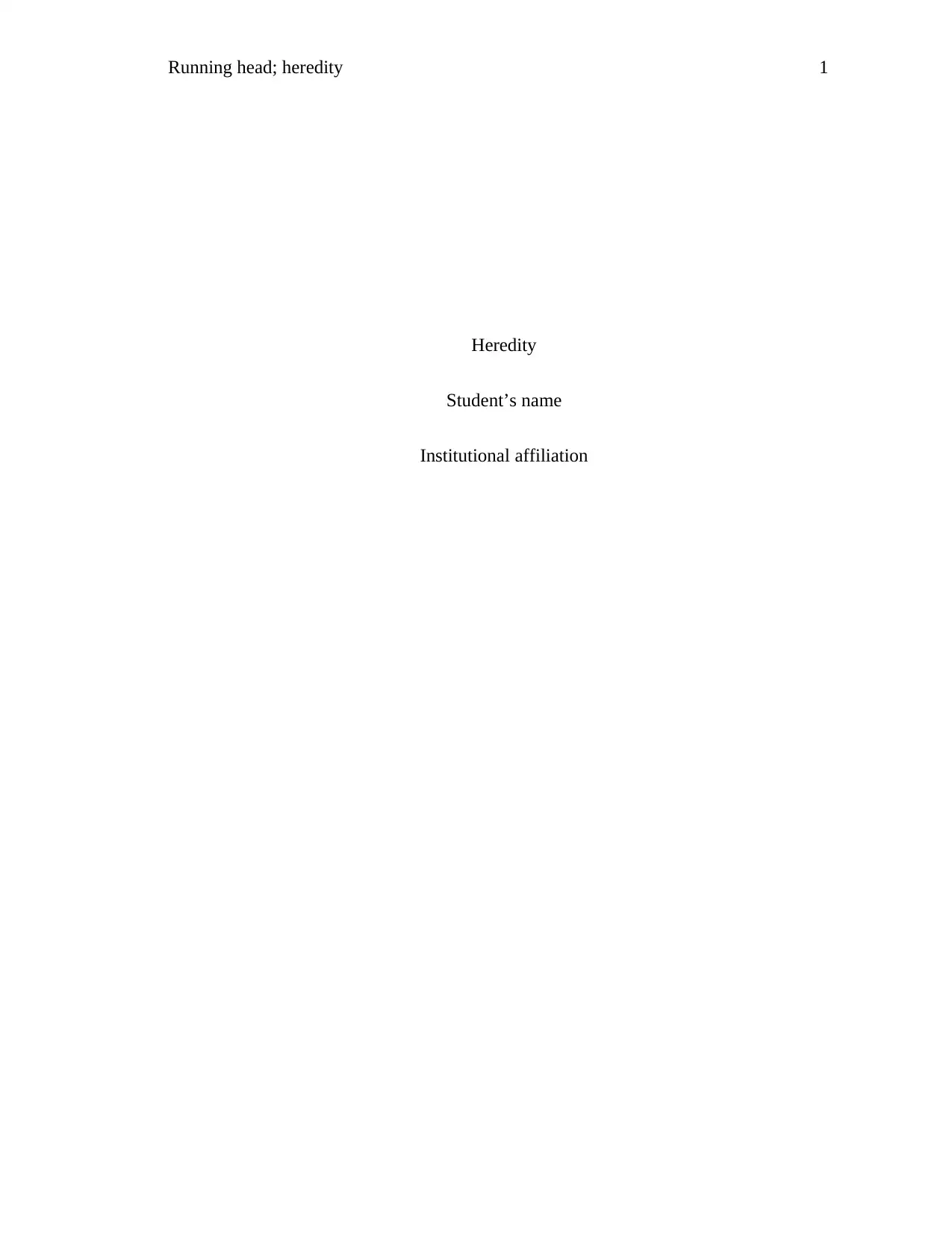
Running head; heredity 1
Heredity
Student’s name
Institutional affiliation
Heredity
Student’s name
Institutional affiliation
Paraphrase This Document
Need a fresh take? Get an instant paraphrase of this document with our AI Paraphraser
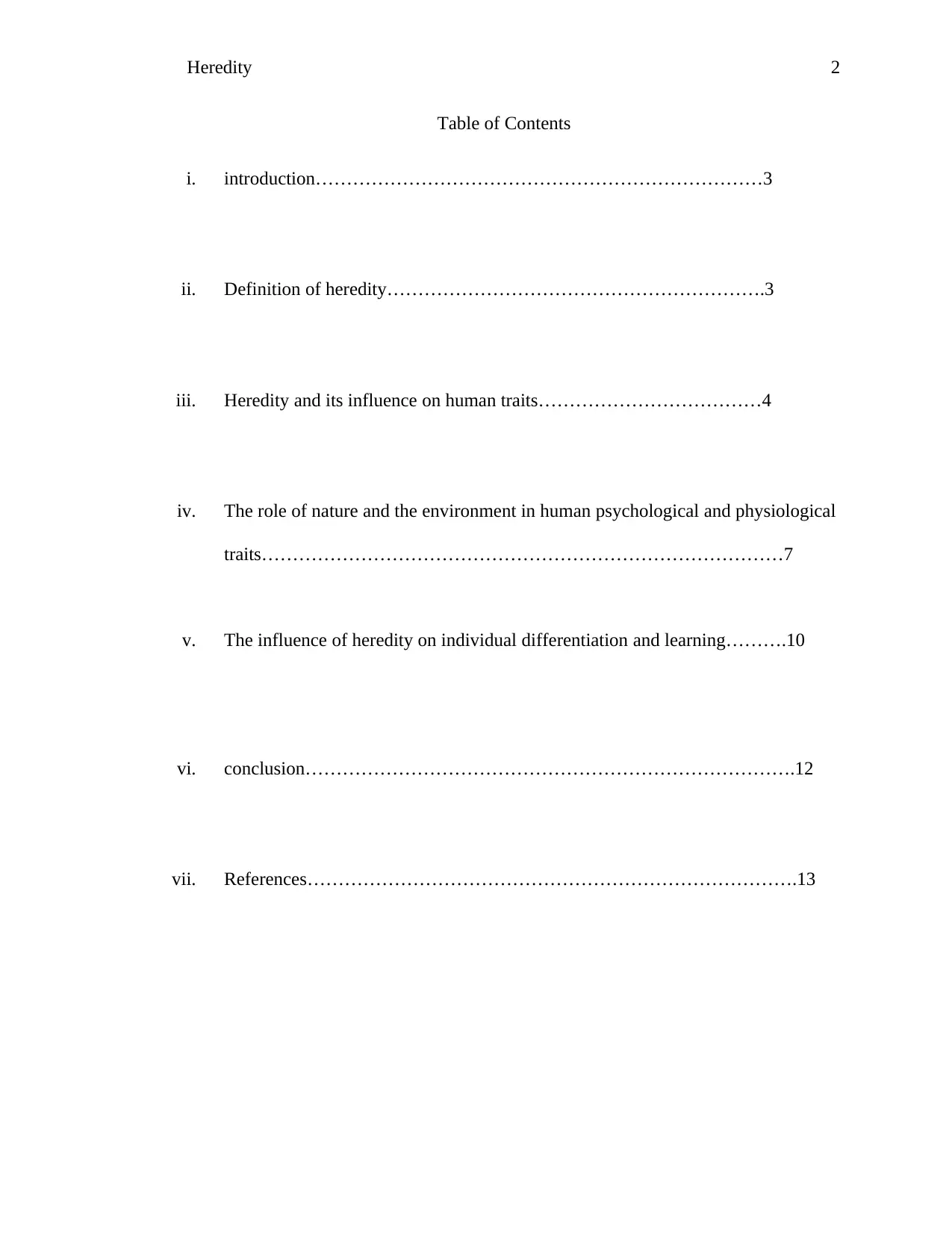
Heredity 2
Table of Contents
i. introduction………………………………………………………………3
ii. Definition of heredity…………………………………………………….3
iii. Heredity and its influence on human traits………………………………4
iv. The role of nature and the environment in human psychological and physiological
traits…………………………………………………………………………7
v. The influence of heredity on individual differentiation and learning……….10
vi. conclusion…………………………………………………………………….12
vii. References…………………………………………………………………….13
Table of Contents
i. introduction………………………………………………………………3
ii. Definition of heredity…………………………………………………….3
iii. Heredity and its influence on human traits………………………………4
iv. The role of nature and the environment in human psychological and physiological
traits…………………………………………………………………………7
v. The influence of heredity on individual differentiation and learning……….10
vi. conclusion…………………………………………………………………….12
vii. References…………………………………………………………………….13
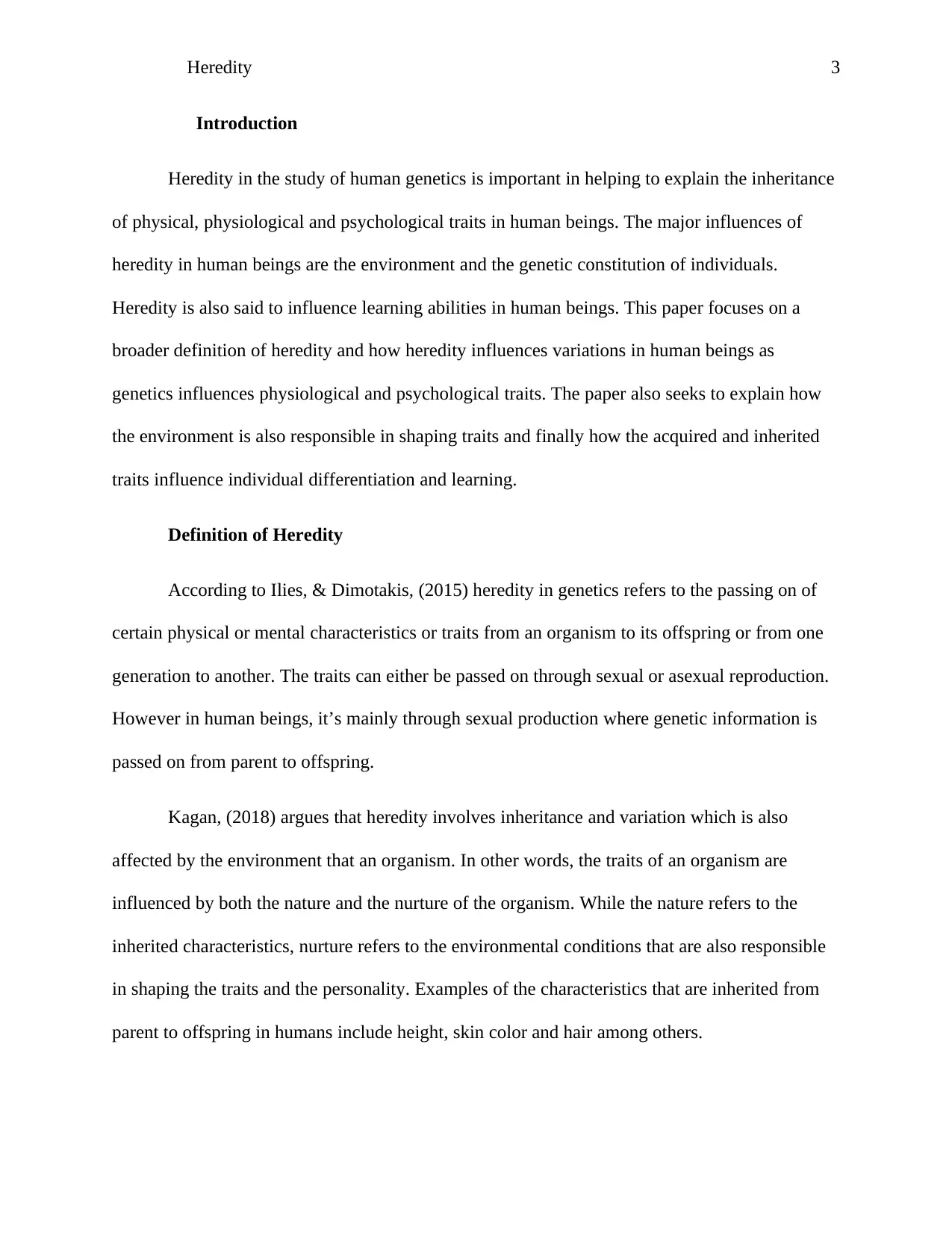
Heredity 3
Introduction
Heredity in the study of human genetics is important in helping to explain the inheritance
of physical, physiological and psychological traits in human beings. The major influences of
heredity in human beings are the environment and the genetic constitution of individuals.
Heredity is also said to influence learning abilities in human beings. This paper focuses on a
broader definition of heredity and how heredity influences variations in human beings as
genetics influences physiological and psychological traits. The paper also seeks to explain how
the environment is also responsible in shaping traits and finally how the acquired and inherited
traits influence individual differentiation and learning.
Definition of Heredity
According to Ilies, & Dimotakis, (2015) heredity in genetics refers to the passing on of
certain physical or mental characteristics or traits from an organism to its offspring or from one
generation to another. The traits can either be passed on through sexual or asexual reproduction.
However in human beings, it’s mainly through sexual production where genetic information is
passed on from parent to offspring.
Kagan, (2018) argues that heredity involves inheritance and variation which is also
affected by the environment that an organism. In other words, the traits of an organism are
influenced by both the nature and the nurture of the organism. While the nature refers to the
inherited characteristics, nurture refers to the environmental conditions that are also responsible
in shaping the traits and the personality. Examples of the characteristics that are inherited from
parent to offspring in humans include height, skin color and hair among others.
Introduction
Heredity in the study of human genetics is important in helping to explain the inheritance
of physical, physiological and psychological traits in human beings. The major influences of
heredity in human beings are the environment and the genetic constitution of individuals.
Heredity is also said to influence learning abilities in human beings. This paper focuses on a
broader definition of heredity and how heredity influences variations in human beings as
genetics influences physiological and psychological traits. The paper also seeks to explain how
the environment is also responsible in shaping traits and finally how the acquired and inherited
traits influence individual differentiation and learning.
Definition of Heredity
According to Ilies, & Dimotakis, (2015) heredity in genetics refers to the passing on of
certain physical or mental characteristics or traits from an organism to its offspring or from one
generation to another. The traits can either be passed on through sexual or asexual reproduction.
However in human beings, it’s mainly through sexual production where genetic information is
passed on from parent to offspring.
Kagan, (2018) argues that heredity involves inheritance and variation which is also
affected by the environment that an organism. In other words, the traits of an organism are
influenced by both the nature and the nurture of the organism. While the nature refers to the
inherited characteristics, nurture refers to the environmental conditions that are also responsible
in shaping the traits and the personality. Examples of the characteristics that are inherited from
parent to offspring in humans include height, skin color and hair among others.
⊘ This is a preview!⊘
Do you want full access?
Subscribe today to unlock all pages.

Trusted by 1+ million students worldwide
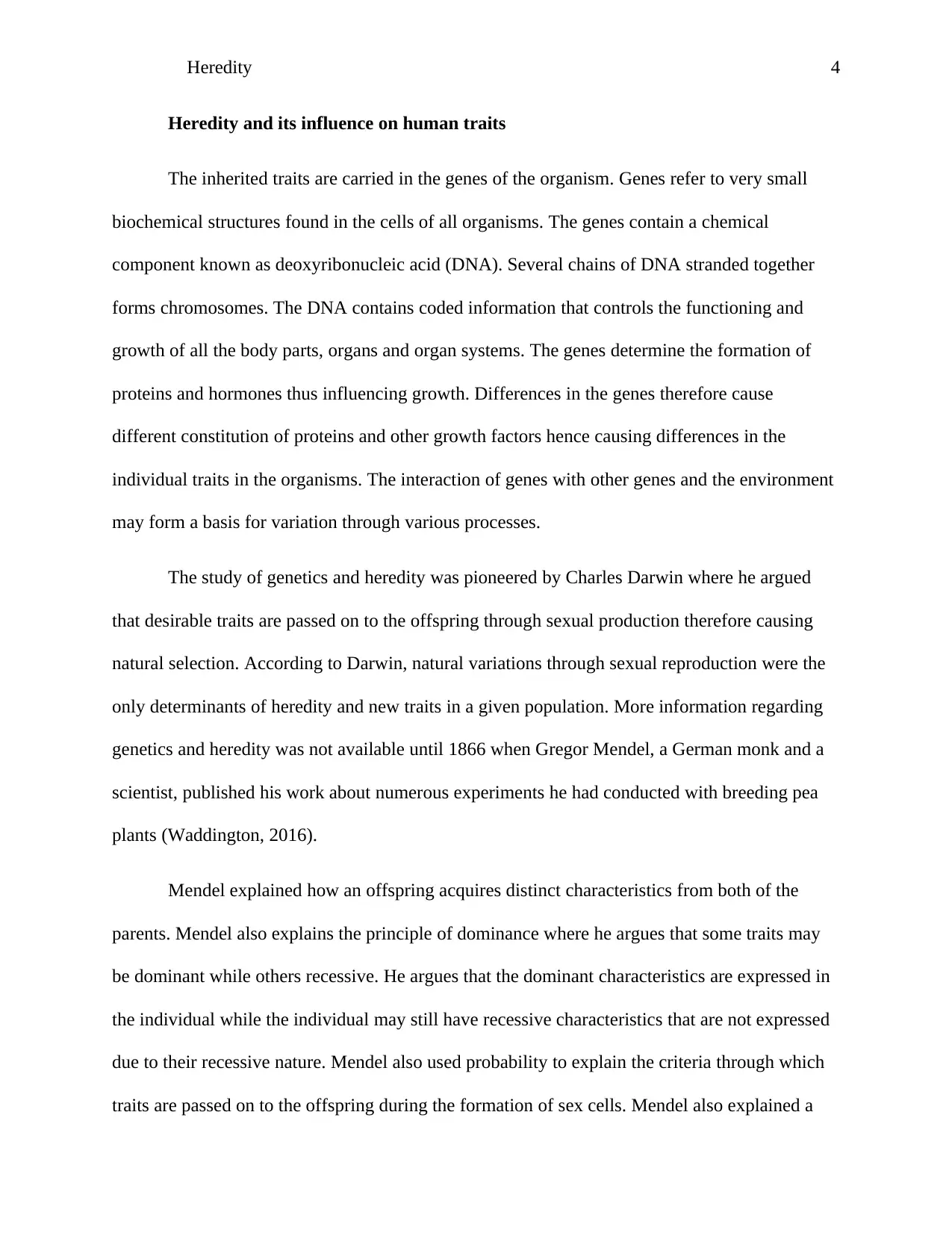
Heredity 4
Heredity and its influence on human traits
The inherited traits are carried in the genes of the organism. Genes refer to very small
biochemical structures found in the cells of all organisms. The genes contain a chemical
component known as deoxyribonucleic acid (DNA). Several chains of DNA stranded together
forms chromosomes. The DNA contains coded information that controls the functioning and
growth of all the body parts, organs and organ systems. The genes determine the formation of
proteins and hormones thus influencing growth. Differences in the genes therefore cause
different constitution of proteins and other growth factors hence causing differences in the
individual traits in the organisms. The interaction of genes with other genes and the environment
may form a basis for variation through various processes.
The study of genetics and heredity was pioneered by Charles Darwin where he argued
that desirable traits are passed on to the offspring through sexual production therefore causing
natural selection. According to Darwin, natural variations through sexual reproduction were the
only determinants of heredity and new traits in a given population. More information regarding
genetics and heredity was not available until 1866 when Gregor Mendel, a German monk and a
scientist, published his work about numerous experiments he had conducted with breeding pea
plants (Waddington, 2016).
Mendel explained how an offspring acquires distinct characteristics from both of the
parents. Mendel also explains the principle of dominance where he argues that some traits may
be dominant while others recessive. He argues that the dominant characteristics are expressed in
the individual while the individual may still have recessive characteristics that are not expressed
due to their recessive nature. Mendel also used probability to explain the criteria through which
traits are passed on to the offspring during the formation of sex cells. Mendel also explained a
Heredity and its influence on human traits
The inherited traits are carried in the genes of the organism. Genes refer to very small
biochemical structures found in the cells of all organisms. The genes contain a chemical
component known as deoxyribonucleic acid (DNA). Several chains of DNA stranded together
forms chromosomes. The DNA contains coded information that controls the functioning and
growth of all the body parts, organs and organ systems. The genes determine the formation of
proteins and hormones thus influencing growth. Differences in the genes therefore cause
different constitution of proteins and other growth factors hence causing differences in the
individual traits in the organisms. The interaction of genes with other genes and the environment
may form a basis for variation through various processes.
The study of genetics and heredity was pioneered by Charles Darwin where he argued
that desirable traits are passed on to the offspring through sexual production therefore causing
natural selection. According to Darwin, natural variations through sexual reproduction were the
only determinants of heredity and new traits in a given population. More information regarding
genetics and heredity was not available until 1866 when Gregor Mendel, a German monk and a
scientist, published his work about numerous experiments he had conducted with breeding pea
plants (Waddington, 2016).
Mendel explained how an offspring acquires distinct characteristics from both of the
parents. Mendel also explains the principle of dominance where he argues that some traits may
be dominant while others recessive. He argues that the dominant characteristics are expressed in
the individual while the individual may still have recessive characteristics that are not expressed
due to their recessive nature. Mendel also used probability to explain the criteria through which
traits are passed on to the offspring during the formation of sex cells. Mendel also explained a
Paraphrase This Document
Need a fresh take? Get an instant paraphrase of this document with our AI Paraphraser
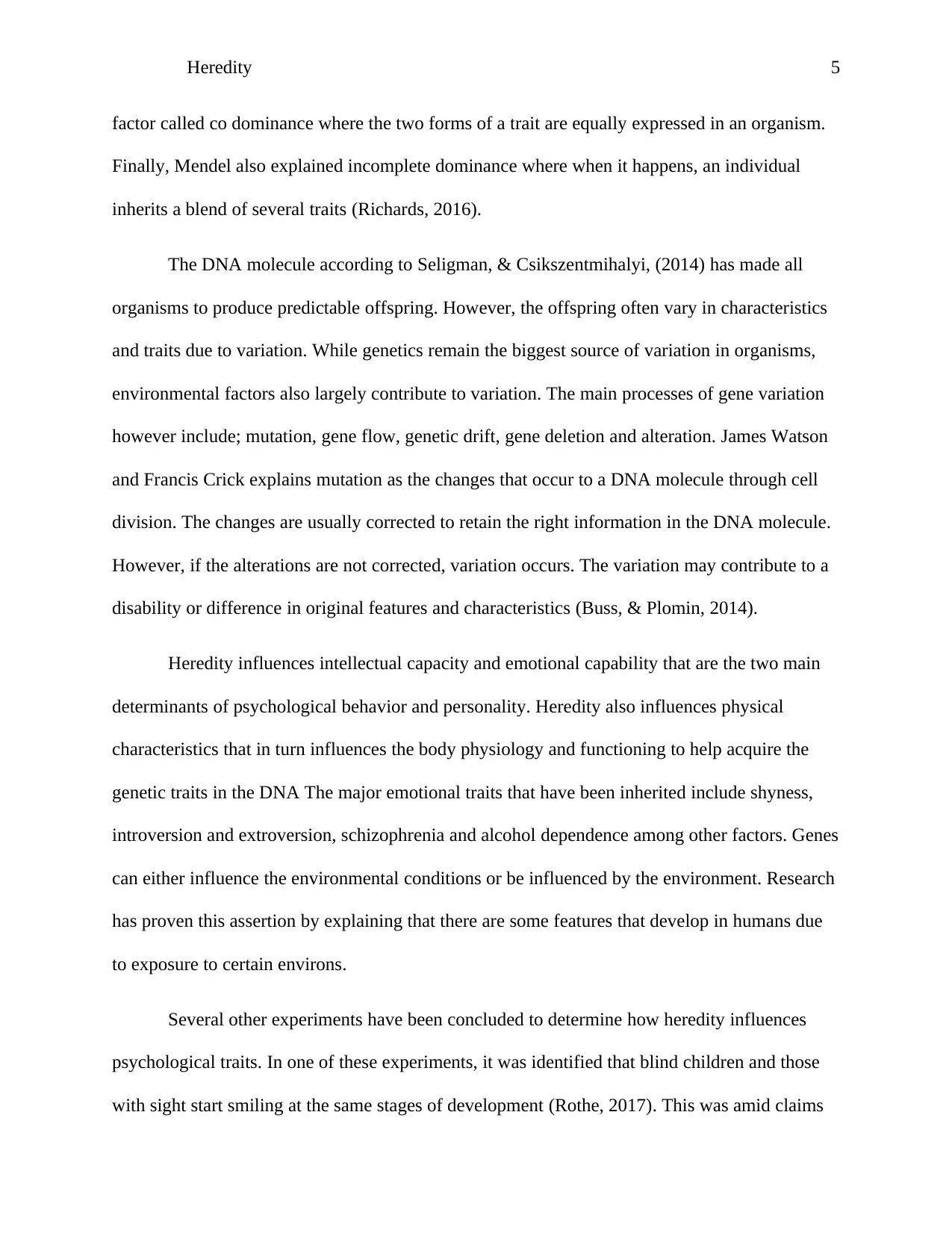
Heredity 5
factor called co dominance where the two forms of a trait are equally expressed in an organism.
Finally, Mendel also explained incomplete dominance where when it happens, an individual
inherits a blend of several traits (Richards, 2016).
The DNA molecule according to Seligman, & Csikszentmihalyi, (2014) has made all
organisms to produce predictable offspring. However, the offspring often vary in characteristics
and traits due to variation. While genetics remain the biggest source of variation in organisms,
environmental factors also largely contribute to variation. The main processes of gene variation
however include; mutation, gene flow, genetic drift, gene deletion and alteration. James Watson
and Francis Crick explains mutation as the changes that occur to a DNA molecule through cell
division. The changes are usually corrected to retain the right information in the DNA molecule.
However, if the alterations are not corrected, variation occurs. The variation may contribute to a
disability or difference in original features and characteristics (Buss, & Plomin, 2014).
Heredity influences intellectual capacity and emotional capability that are the two main
determinants of psychological behavior and personality. Heredity also influences physical
characteristics that in turn influences the body physiology and functioning to help acquire the
genetic traits in the DNA The major emotional traits that have been inherited include shyness,
introversion and extroversion, schizophrenia and alcohol dependence among other factors. Genes
can either influence the environmental conditions or be influenced by the environment. Research
has proven this assertion by explaining that there are some features that develop in humans due
to exposure to certain environs.
Several other experiments have been concluded to determine how heredity influences
psychological traits. In one of these experiments, it was identified that blind children and those
with sight start smiling at the same stages of development (Rothe, 2017). This was amid claims
factor called co dominance where the two forms of a trait are equally expressed in an organism.
Finally, Mendel also explained incomplete dominance where when it happens, an individual
inherits a blend of several traits (Richards, 2016).
The DNA molecule according to Seligman, & Csikszentmihalyi, (2014) has made all
organisms to produce predictable offspring. However, the offspring often vary in characteristics
and traits due to variation. While genetics remain the biggest source of variation in organisms,
environmental factors also largely contribute to variation. The main processes of gene variation
however include; mutation, gene flow, genetic drift, gene deletion and alteration. James Watson
and Francis Crick explains mutation as the changes that occur to a DNA molecule through cell
division. The changes are usually corrected to retain the right information in the DNA molecule.
However, if the alterations are not corrected, variation occurs. The variation may contribute to a
disability or difference in original features and characteristics (Buss, & Plomin, 2014).
Heredity influences intellectual capacity and emotional capability that are the two main
determinants of psychological behavior and personality. Heredity also influences physical
characteristics that in turn influences the body physiology and functioning to help acquire the
genetic traits in the DNA The major emotional traits that have been inherited include shyness,
introversion and extroversion, schizophrenia and alcohol dependence among other factors. Genes
can either influence the environmental conditions or be influenced by the environment. Research
has proven this assertion by explaining that there are some features that develop in humans due
to exposure to certain environs.
Several other experiments have been concluded to determine how heredity influences
psychological traits. In one of these experiments, it was identified that blind children and those
with sight start smiling at the same stages of development (Rothe, 2017). This was amid claims
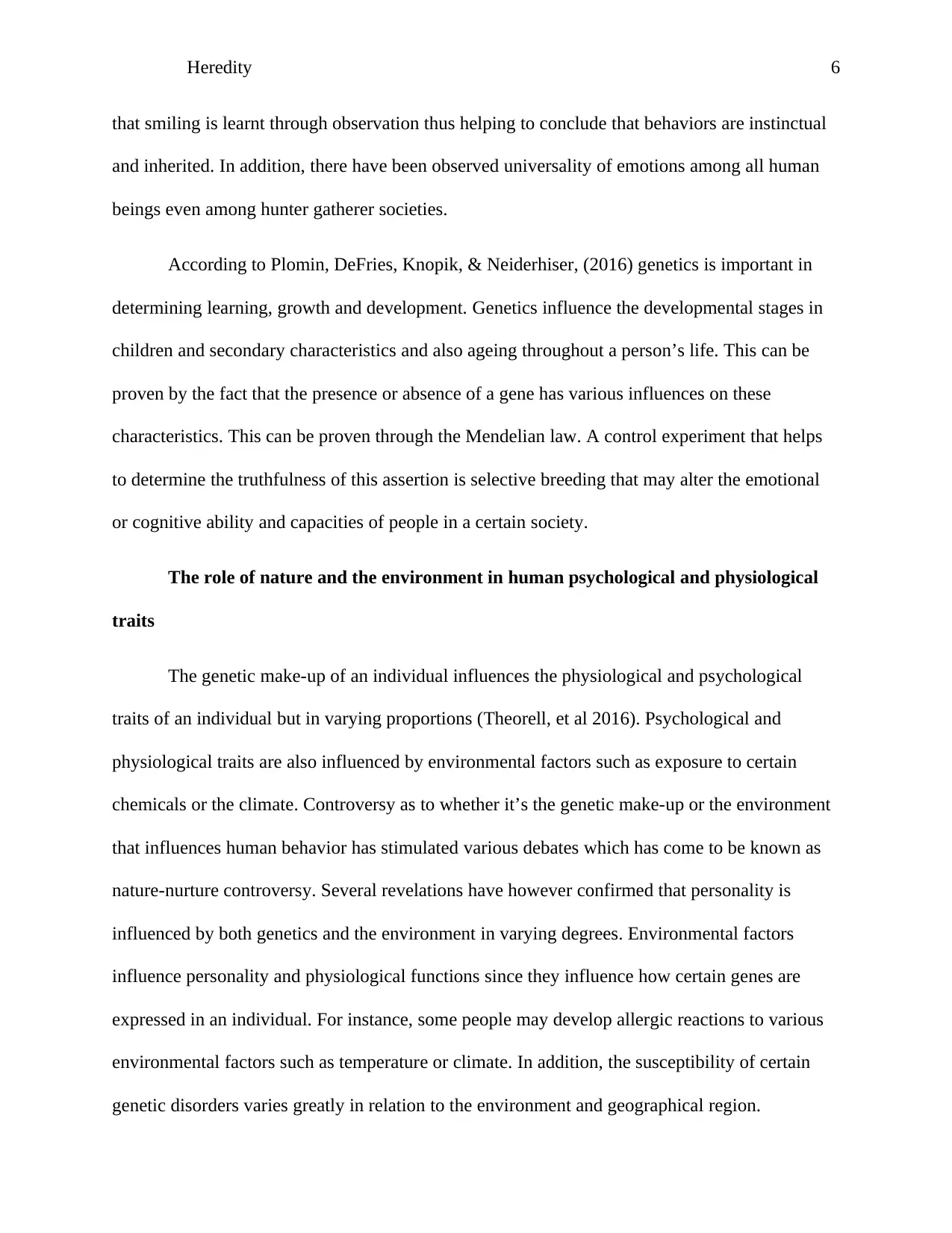
Heredity 6
that smiling is learnt through observation thus helping to conclude that behaviors are instinctual
and inherited. In addition, there have been observed universality of emotions among all human
beings even among hunter gatherer societies.
According to Plomin, DeFries, Knopik, & Neiderhiser, (2016) genetics is important in
determining learning, growth and development. Genetics influence the developmental stages in
children and secondary characteristics and also ageing throughout a person’s life. This can be
proven by the fact that the presence or absence of a gene has various influences on these
characteristics. This can be proven through the Mendelian law. A control experiment that helps
to determine the truthfulness of this assertion is selective breeding that may alter the emotional
or cognitive ability and capacities of people in a certain society.
The role of nature and the environment in human psychological and physiological
traits
The genetic make-up of an individual influences the physiological and psychological
traits of an individual but in varying proportions (Theorell, et al 2016). Psychological and
physiological traits are also influenced by environmental factors such as exposure to certain
chemicals or the climate. Controversy as to whether it’s the genetic make-up or the environment
that influences human behavior has stimulated various debates which has come to be known as
nature-nurture controversy. Several revelations have however confirmed that personality is
influenced by both genetics and the environment in varying degrees. Environmental factors
influence personality and physiological functions since they influence how certain genes are
expressed in an individual. For instance, some people may develop allergic reactions to various
environmental factors such as temperature or climate. In addition, the susceptibility of certain
genetic disorders varies greatly in relation to the environment and geographical region.
that smiling is learnt through observation thus helping to conclude that behaviors are instinctual
and inherited. In addition, there have been observed universality of emotions among all human
beings even among hunter gatherer societies.
According to Plomin, DeFries, Knopik, & Neiderhiser, (2016) genetics is important in
determining learning, growth and development. Genetics influence the developmental stages in
children and secondary characteristics and also ageing throughout a person’s life. This can be
proven by the fact that the presence or absence of a gene has various influences on these
characteristics. This can be proven through the Mendelian law. A control experiment that helps
to determine the truthfulness of this assertion is selective breeding that may alter the emotional
or cognitive ability and capacities of people in a certain society.
The role of nature and the environment in human psychological and physiological
traits
The genetic make-up of an individual influences the physiological and psychological
traits of an individual but in varying proportions (Theorell, et al 2016). Psychological and
physiological traits are also influenced by environmental factors such as exposure to certain
chemicals or the climate. Controversy as to whether it’s the genetic make-up or the environment
that influences human behavior has stimulated various debates which has come to be known as
nature-nurture controversy. Several revelations have however confirmed that personality is
influenced by both genetics and the environment in varying degrees. Environmental factors
influence personality and physiological functions since they influence how certain genes are
expressed in an individual. For instance, some people may develop allergic reactions to various
environmental factors such as temperature or climate. In addition, the susceptibility of certain
genetic disorders varies greatly in relation to the environment and geographical region.
⊘ This is a preview!⊘
Do you want full access?
Subscribe today to unlock all pages.

Trusted by 1+ million students worldwide
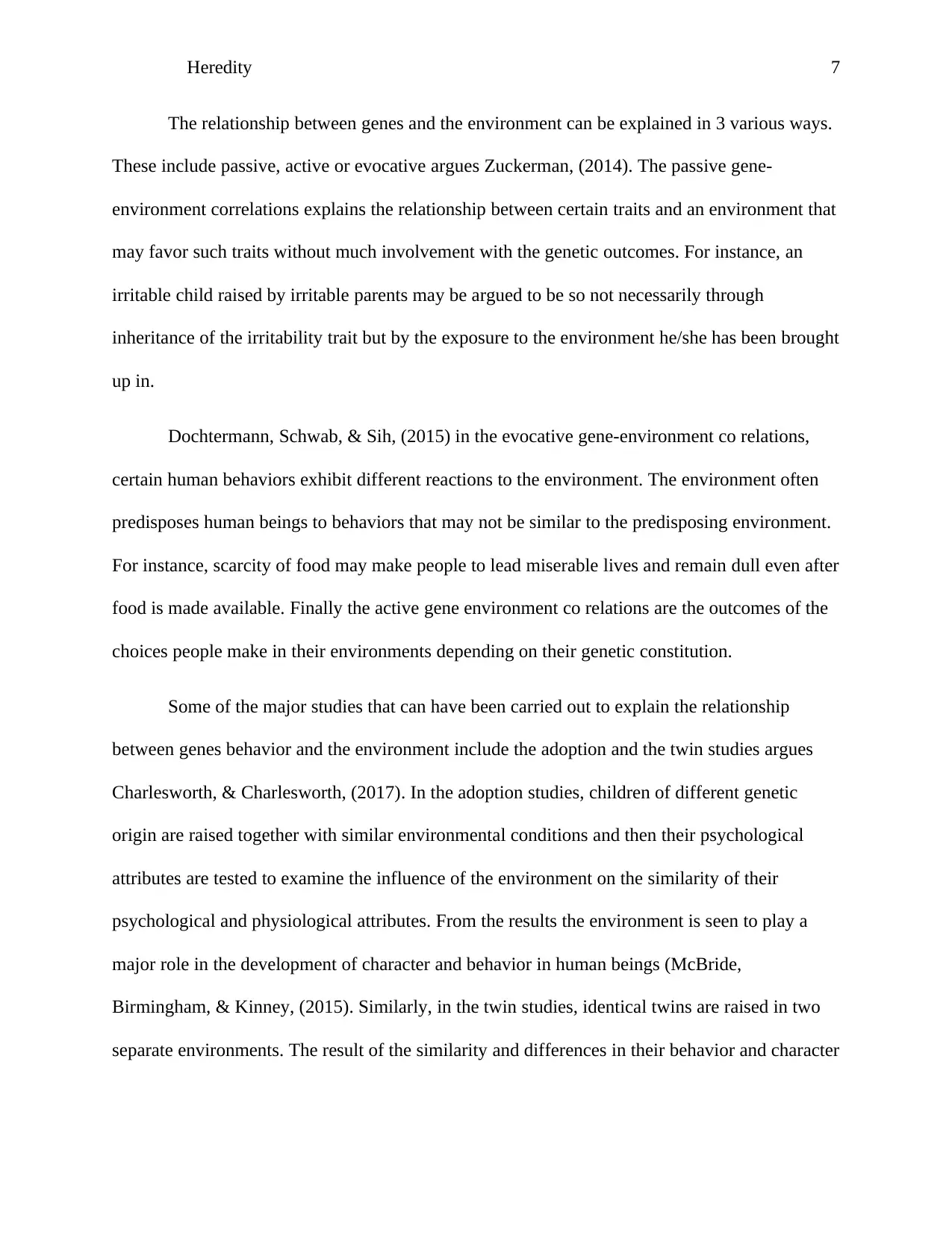
Heredity 7
The relationship between genes and the environment can be explained in 3 various ways.
These include passive, active or evocative argues Zuckerman, (2014). The passive gene-
environment correlations explains the relationship between certain traits and an environment that
may favor such traits without much involvement with the genetic outcomes. For instance, an
irritable child raised by irritable parents may be argued to be so not necessarily through
inheritance of the irritability trait but by the exposure to the environment he/she has been brought
up in.
Dochtermann, Schwab, & Sih, (2015) in the evocative gene-environment co relations,
certain human behaviors exhibit different reactions to the environment. The environment often
predisposes human beings to behaviors that may not be similar to the predisposing environment.
For instance, scarcity of food may make people to lead miserable lives and remain dull even after
food is made available. Finally the active gene environment co relations are the outcomes of the
choices people make in their environments depending on their genetic constitution.
Some of the major studies that can have been carried out to explain the relationship
between genes behavior and the environment include the adoption and the twin studies argues
Charlesworth, & Charlesworth, (2017). In the adoption studies, children of different genetic
origin are raised together with similar environmental conditions and then their psychological
attributes are tested to examine the influence of the environment on the similarity of their
psychological and physiological attributes. From the results the environment is seen to play a
major role in the development of character and behavior in human beings (McBride,
Birmingham, & Kinney, (2015). Similarly, in the twin studies, identical twins are raised in two
separate environments. The result of the similarity and differences in their behavior and character
The relationship between genes and the environment can be explained in 3 various ways.
These include passive, active or evocative argues Zuckerman, (2014). The passive gene-
environment correlations explains the relationship between certain traits and an environment that
may favor such traits without much involvement with the genetic outcomes. For instance, an
irritable child raised by irritable parents may be argued to be so not necessarily through
inheritance of the irritability trait but by the exposure to the environment he/she has been brought
up in.
Dochtermann, Schwab, & Sih, (2015) in the evocative gene-environment co relations,
certain human behaviors exhibit different reactions to the environment. The environment often
predisposes human beings to behaviors that may not be similar to the predisposing environment.
For instance, scarcity of food may make people to lead miserable lives and remain dull even after
food is made available. Finally the active gene environment co relations are the outcomes of the
choices people make in their environments depending on their genetic constitution.
Some of the major studies that can have been carried out to explain the relationship
between genes behavior and the environment include the adoption and the twin studies argues
Charlesworth, & Charlesworth, (2017). In the adoption studies, children of different genetic
origin are raised together with similar environmental conditions and then their psychological
attributes are tested to examine the influence of the environment on the similarity of their
psychological and physiological attributes. From the results the environment is seen to play a
major role in the development of character and behavior in human beings (McBride,
Birmingham, & Kinney, (2015). Similarly, in the twin studies, identical twins are raised in two
separate environments. The result of the similarity and differences in their behavior and character
Paraphrase This Document
Need a fresh take? Get an instant paraphrase of this document with our AI Paraphraser
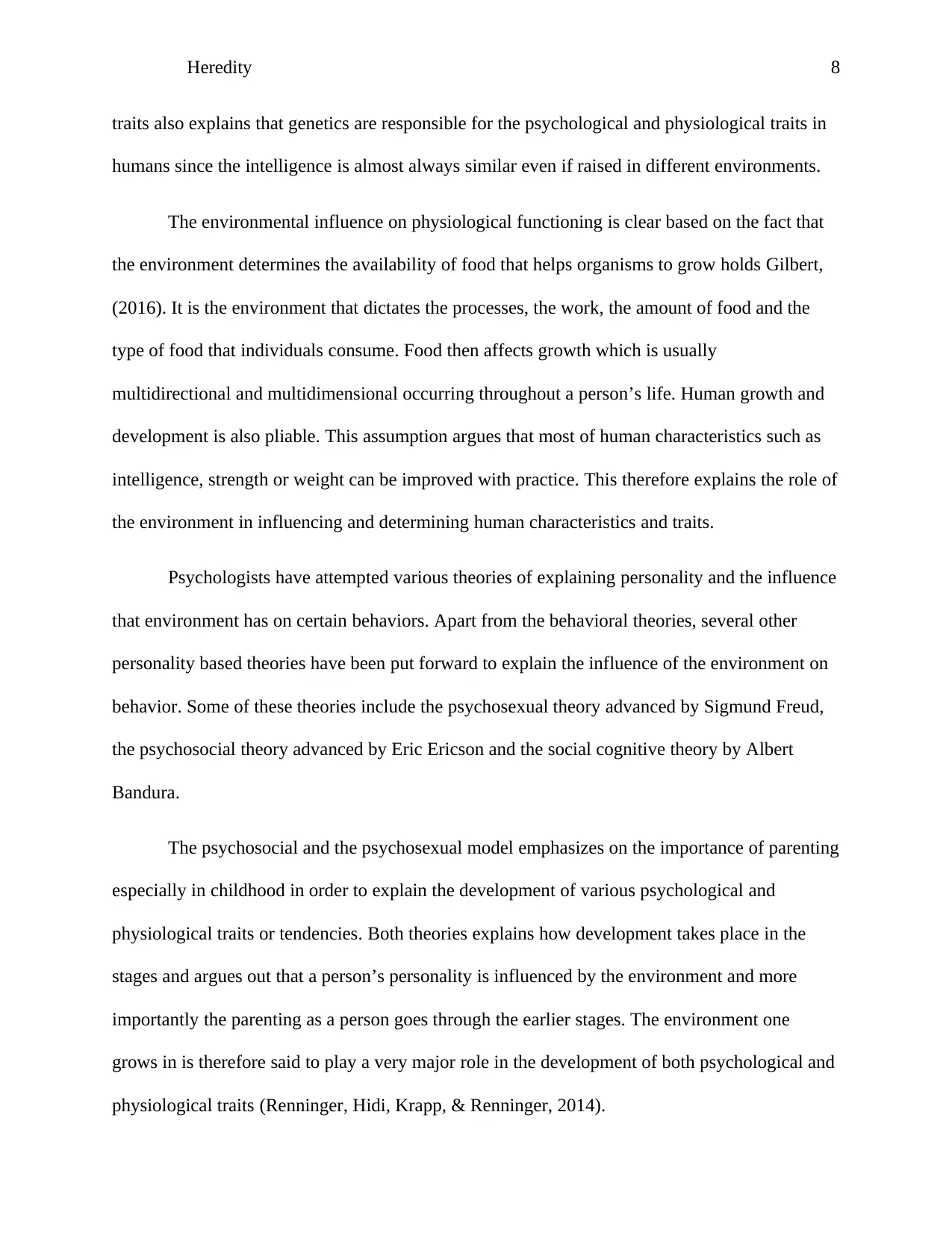
Heredity 8
traits also explains that genetics are responsible for the psychological and physiological traits in
humans since the intelligence is almost always similar even if raised in different environments.
The environmental influence on physiological functioning is clear based on the fact that
the environment determines the availability of food that helps organisms to grow holds Gilbert,
(2016). It is the environment that dictates the processes, the work, the amount of food and the
type of food that individuals consume. Food then affects growth which is usually
multidirectional and multidimensional occurring throughout a person’s life. Human growth and
development is also pliable. This assumption argues that most of human characteristics such as
intelligence, strength or weight can be improved with practice. This therefore explains the role of
the environment in influencing and determining human characteristics and traits.
Psychologists have attempted various theories of explaining personality and the influence
that environment has on certain behaviors. Apart from the behavioral theories, several other
personality based theories have been put forward to explain the influence of the environment on
behavior. Some of these theories include the psychosexual theory advanced by Sigmund Freud,
the psychosocial theory advanced by Eric Ericson and the social cognitive theory by Albert
Bandura.
The psychosocial and the psychosexual model emphasizes on the importance of parenting
especially in childhood in order to explain the development of various psychological and
physiological traits or tendencies. Both theories explains how development takes place in the
stages and argues out that a person’s personality is influenced by the environment and more
importantly the parenting as a person goes through the earlier stages. The environment one
grows in is therefore said to play a very major role in the development of both psychological and
physiological traits (Renninger, Hidi, Krapp, & Renninger, 2014).
traits also explains that genetics are responsible for the psychological and physiological traits in
humans since the intelligence is almost always similar even if raised in different environments.
The environmental influence on physiological functioning is clear based on the fact that
the environment determines the availability of food that helps organisms to grow holds Gilbert,
(2016). It is the environment that dictates the processes, the work, the amount of food and the
type of food that individuals consume. Food then affects growth which is usually
multidirectional and multidimensional occurring throughout a person’s life. Human growth and
development is also pliable. This assumption argues that most of human characteristics such as
intelligence, strength or weight can be improved with practice. This therefore explains the role of
the environment in influencing and determining human characteristics and traits.
Psychologists have attempted various theories of explaining personality and the influence
that environment has on certain behaviors. Apart from the behavioral theories, several other
personality based theories have been put forward to explain the influence of the environment on
behavior. Some of these theories include the psychosexual theory advanced by Sigmund Freud,
the psychosocial theory advanced by Eric Ericson and the social cognitive theory by Albert
Bandura.
The psychosocial and the psychosexual model emphasizes on the importance of parenting
especially in childhood in order to explain the development of various psychological and
physiological traits or tendencies. Both theories explains how development takes place in the
stages and argues out that a person’s personality is influenced by the environment and more
importantly the parenting as a person goes through the earlier stages. The environment one
grows in is therefore said to play a very major role in the development of both psychological and
physiological traits (Renninger, Hidi, Krapp, & Renninger, 2014).
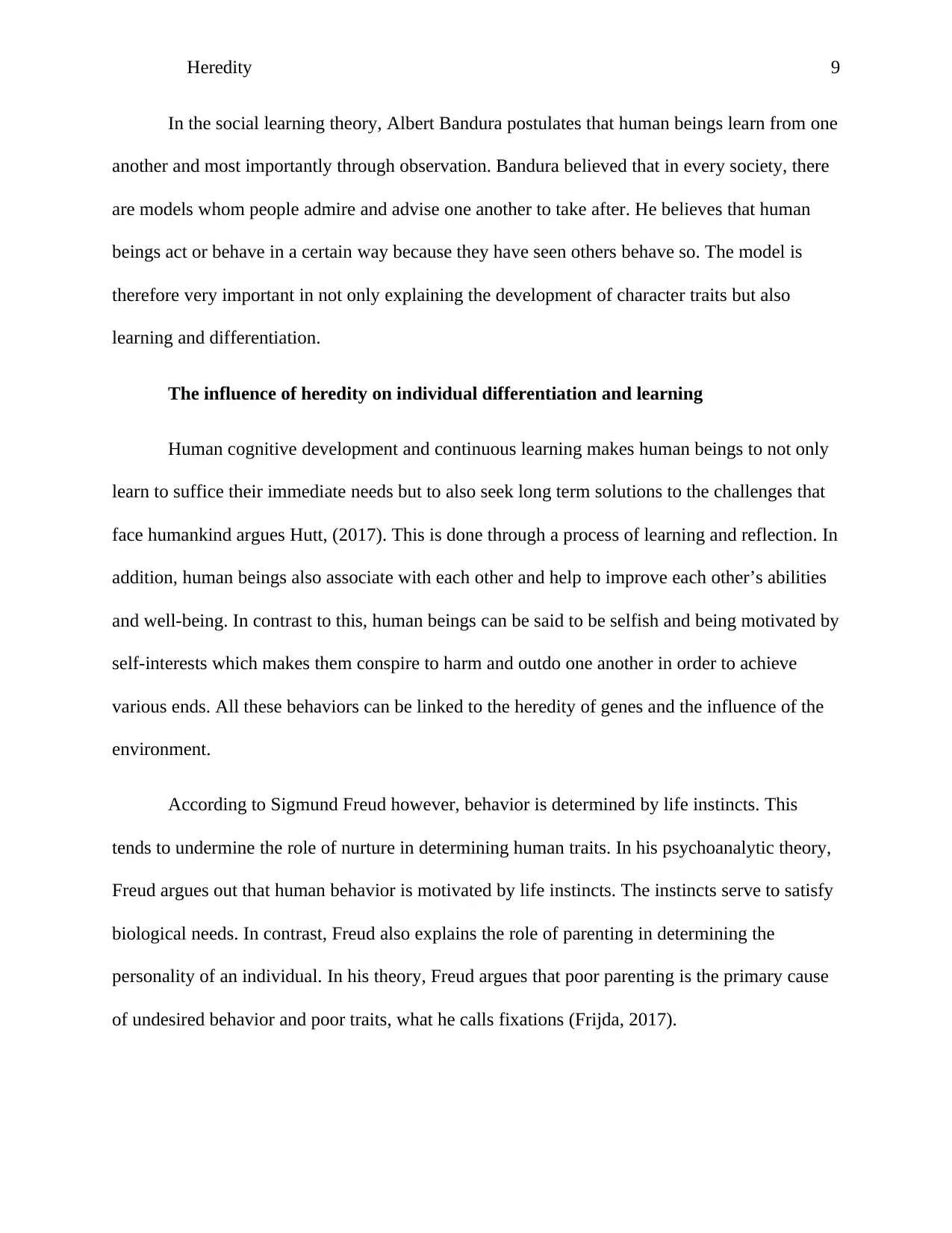
Heredity 9
In the social learning theory, Albert Bandura postulates that human beings learn from one
another and most importantly through observation. Bandura believed that in every society, there
are models whom people admire and advise one another to take after. He believes that human
beings act or behave in a certain way because they have seen others behave so. The model is
therefore very important in not only explaining the development of character traits but also
learning and differentiation.
The influence of heredity on individual differentiation and learning
Human cognitive development and continuous learning makes human beings to not only
learn to suffice their immediate needs but to also seek long term solutions to the challenges that
face humankind argues Hutt, (2017). This is done through a process of learning and reflection. In
addition, human beings also associate with each other and help to improve each other’s abilities
and well-being. In contrast to this, human beings can be said to be selfish and being motivated by
self-interests which makes them conspire to harm and outdo one another in order to achieve
various ends. All these behaviors can be linked to the heredity of genes and the influence of the
environment.
According to Sigmund Freud however, behavior is determined by life instincts. This
tends to undermine the role of nurture in determining human traits. In his psychoanalytic theory,
Freud argues out that human behavior is motivated by life instincts. The instincts serve to satisfy
biological needs. In contrast, Freud also explains the role of parenting in determining the
personality of an individual. In his theory, Freud argues that poor parenting is the primary cause
of undesired behavior and poor traits, what he calls fixations (Frijda, 2017).
In the social learning theory, Albert Bandura postulates that human beings learn from one
another and most importantly through observation. Bandura believed that in every society, there
are models whom people admire and advise one another to take after. He believes that human
beings act or behave in a certain way because they have seen others behave so. The model is
therefore very important in not only explaining the development of character traits but also
learning and differentiation.
The influence of heredity on individual differentiation and learning
Human cognitive development and continuous learning makes human beings to not only
learn to suffice their immediate needs but to also seek long term solutions to the challenges that
face humankind argues Hutt, (2017). This is done through a process of learning and reflection. In
addition, human beings also associate with each other and help to improve each other’s abilities
and well-being. In contrast to this, human beings can be said to be selfish and being motivated by
self-interests which makes them conspire to harm and outdo one another in order to achieve
various ends. All these behaviors can be linked to the heredity of genes and the influence of the
environment.
According to Sigmund Freud however, behavior is determined by life instincts. This
tends to undermine the role of nurture in determining human traits. In his psychoanalytic theory,
Freud argues out that human behavior is motivated by life instincts. The instincts serve to satisfy
biological needs. In contrast, Freud also explains the role of parenting in determining the
personality of an individual. In his theory, Freud argues that poor parenting is the primary cause
of undesired behavior and poor traits, what he calls fixations (Frijda, 2017).
⊘ This is a preview!⊘
Do you want full access?
Subscribe today to unlock all pages.

Trusted by 1+ million students worldwide
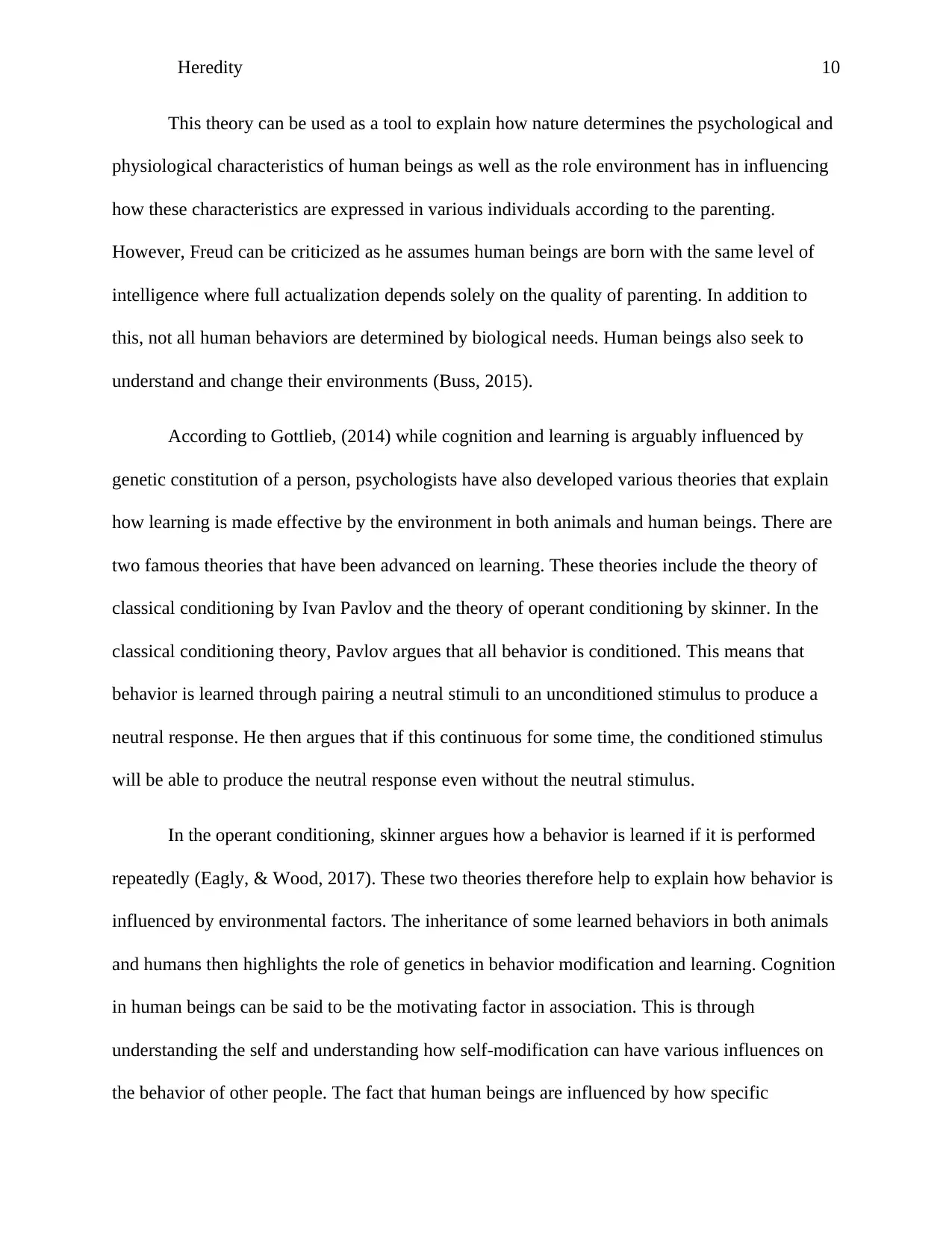
Heredity 10
This theory can be used as a tool to explain how nature determines the psychological and
physiological characteristics of human beings as well as the role environment has in influencing
how these characteristics are expressed in various individuals according to the parenting.
However, Freud can be criticized as he assumes human beings are born with the same level of
intelligence where full actualization depends solely on the quality of parenting. In addition to
this, not all human behaviors are determined by biological needs. Human beings also seek to
understand and change their environments (Buss, 2015).
According to Gottlieb, (2014) while cognition and learning is arguably influenced by
genetic constitution of a person, psychologists have also developed various theories that explain
how learning is made effective by the environment in both animals and human beings. There are
two famous theories that have been advanced on learning. These theories include the theory of
classical conditioning by Ivan Pavlov and the theory of operant conditioning by skinner. In the
classical conditioning theory, Pavlov argues that all behavior is conditioned. This means that
behavior is learned through pairing a neutral stimuli to an unconditioned stimulus to produce a
neutral response. He then argues that if this continuous for some time, the conditioned stimulus
will be able to produce the neutral response even without the neutral stimulus.
In the operant conditioning, skinner argues how a behavior is learned if it is performed
repeatedly (Eagly, & Wood, 2017). These two theories therefore help to explain how behavior is
influenced by environmental factors. The inheritance of some learned behaviors in both animals
and humans then highlights the role of genetics in behavior modification and learning. Cognition
in human beings can be said to be the motivating factor in association. This is through
understanding the self and understanding how self-modification can have various influences on
the behavior of other people. The fact that human beings are influenced by how specific
This theory can be used as a tool to explain how nature determines the psychological and
physiological characteristics of human beings as well as the role environment has in influencing
how these characteristics are expressed in various individuals according to the parenting.
However, Freud can be criticized as he assumes human beings are born with the same level of
intelligence where full actualization depends solely on the quality of parenting. In addition to
this, not all human behaviors are determined by biological needs. Human beings also seek to
understand and change their environments (Buss, 2015).
According to Gottlieb, (2014) while cognition and learning is arguably influenced by
genetic constitution of a person, psychologists have also developed various theories that explain
how learning is made effective by the environment in both animals and human beings. There are
two famous theories that have been advanced on learning. These theories include the theory of
classical conditioning by Ivan Pavlov and the theory of operant conditioning by skinner. In the
classical conditioning theory, Pavlov argues that all behavior is conditioned. This means that
behavior is learned through pairing a neutral stimuli to an unconditioned stimulus to produce a
neutral response. He then argues that if this continuous for some time, the conditioned stimulus
will be able to produce the neutral response even without the neutral stimulus.
In the operant conditioning, skinner argues how a behavior is learned if it is performed
repeatedly (Eagly, & Wood, 2017). These two theories therefore help to explain how behavior is
influenced by environmental factors. The inheritance of some learned behaviors in both animals
and humans then highlights the role of genetics in behavior modification and learning. Cognition
in human beings can be said to be the motivating factor in association. This is through
understanding the self and understanding how self-modification can have various influences on
the behavior of other people. The fact that human beings are influenced by how specific
Paraphrase This Document
Need a fresh take? Get an instant paraphrase of this document with our AI Paraphraser
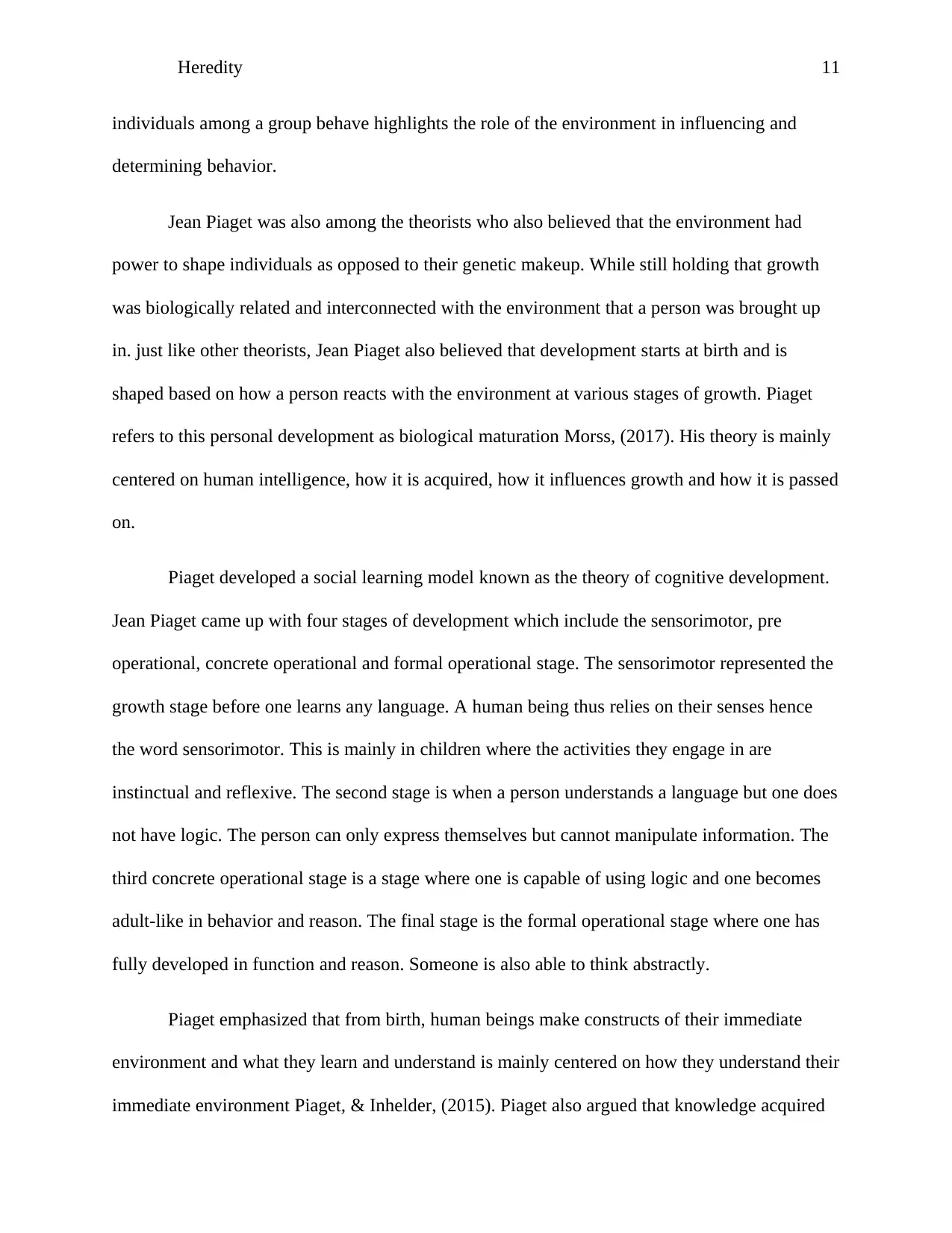
Heredity 11
individuals among a group behave highlights the role of the environment in influencing and
determining behavior.
Jean Piaget was also among the theorists who also believed that the environment had
power to shape individuals as opposed to their genetic makeup. While still holding that growth
was biologically related and interconnected with the environment that a person was brought up
in. just like other theorists, Jean Piaget also believed that development starts at birth and is
shaped based on how a person reacts with the environment at various stages of growth. Piaget
refers to this personal development as biological maturation Morss, (2017). His theory is mainly
centered on human intelligence, how it is acquired, how it influences growth and how it is passed
on.
Piaget developed a social learning model known as the theory of cognitive development.
Jean Piaget came up with four stages of development which include the sensorimotor, pre
operational, concrete operational and formal operational stage. The sensorimotor represented the
growth stage before one learns any language. A human being thus relies on their senses hence
the word sensorimotor. This is mainly in children where the activities they engage in are
instinctual and reflexive. The second stage is when a person understands a language but one does
not have logic. The person can only express themselves but cannot manipulate information. The
third concrete operational stage is a stage where one is capable of using logic and one becomes
adult-like in behavior and reason. The final stage is the formal operational stage where one has
fully developed in function and reason. Someone is also able to think abstractly.
Piaget emphasized that from birth, human beings make constructs of their immediate
environment and what they learn and understand is mainly centered on how they understand their
immediate environment Piaget, & Inhelder, (2015). Piaget also argued that knowledge acquired
individuals among a group behave highlights the role of the environment in influencing and
determining behavior.
Jean Piaget was also among the theorists who also believed that the environment had
power to shape individuals as opposed to their genetic makeup. While still holding that growth
was biologically related and interconnected with the environment that a person was brought up
in. just like other theorists, Jean Piaget also believed that development starts at birth and is
shaped based on how a person reacts with the environment at various stages of growth. Piaget
refers to this personal development as biological maturation Morss, (2017). His theory is mainly
centered on human intelligence, how it is acquired, how it influences growth and how it is passed
on.
Piaget developed a social learning model known as the theory of cognitive development.
Jean Piaget came up with four stages of development which include the sensorimotor, pre
operational, concrete operational and formal operational stage. The sensorimotor represented the
growth stage before one learns any language. A human being thus relies on their senses hence
the word sensorimotor. This is mainly in children where the activities they engage in are
instinctual and reflexive. The second stage is when a person understands a language but one does
not have logic. The person can only express themselves but cannot manipulate information. The
third concrete operational stage is a stage where one is capable of using logic and one becomes
adult-like in behavior and reason. The final stage is the formal operational stage where one has
fully developed in function and reason. Someone is also able to think abstractly.
Piaget emphasized that from birth, human beings make constructs of their immediate
environment and what they learn and understand is mainly centered on how they understand their
immediate environment Piaget, & Inhelder, (2015). Piaget also argued that knowledge acquired
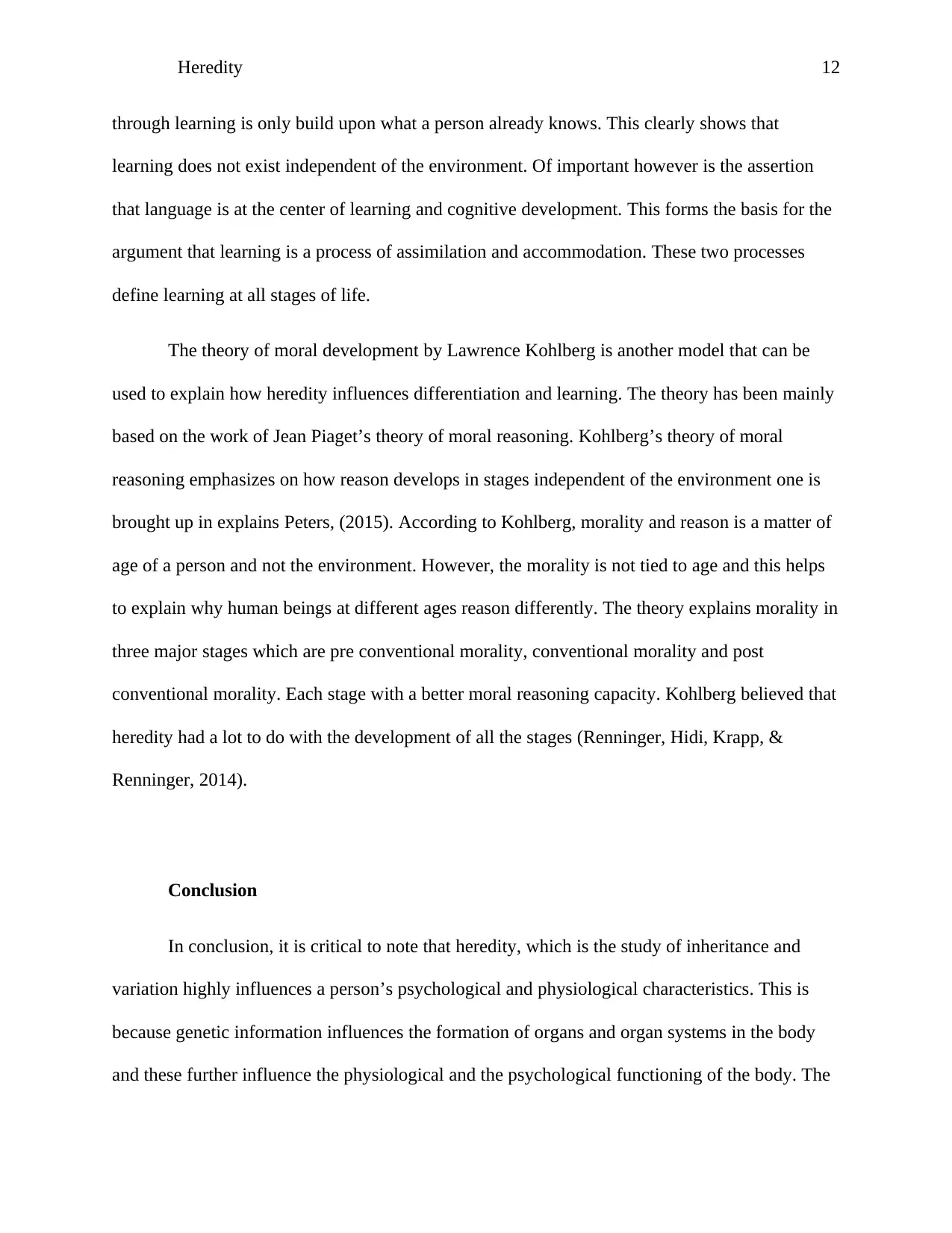
Heredity 12
through learning is only build upon what a person already knows. This clearly shows that
learning does not exist independent of the environment. Of important however is the assertion
that language is at the center of learning and cognitive development. This forms the basis for the
argument that learning is a process of assimilation and accommodation. These two processes
define learning at all stages of life.
The theory of moral development by Lawrence Kohlberg is another model that can be
used to explain how heredity influences differentiation and learning. The theory has been mainly
based on the work of Jean Piaget’s theory of moral reasoning. Kohlberg’s theory of moral
reasoning emphasizes on how reason develops in stages independent of the environment one is
brought up in explains Peters, (2015). According to Kohlberg, morality and reason is a matter of
age of a person and not the environment. However, the morality is not tied to age and this helps
to explain why human beings at different ages reason differently. The theory explains morality in
three major stages which are pre conventional morality, conventional morality and post
conventional morality. Each stage with a better moral reasoning capacity. Kohlberg believed that
heredity had a lot to do with the development of all the stages (Renninger, Hidi, Krapp, &
Renninger, 2014).
Conclusion
In conclusion, it is critical to note that heredity, which is the study of inheritance and
variation highly influences a person’s psychological and physiological characteristics. This is
because genetic information influences the formation of organs and organ systems in the body
and these further influence the physiological and the psychological functioning of the body. The
through learning is only build upon what a person already knows. This clearly shows that
learning does not exist independent of the environment. Of important however is the assertion
that language is at the center of learning and cognitive development. This forms the basis for the
argument that learning is a process of assimilation and accommodation. These two processes
define learning at all stages of life.
The theory of moral development by Lawrence Kohlberg is another model that can be
used to explain how heredity influences differentiation and learning. The theory has been mainly
based on the work of Jean Piaget’s theory of moral reasoning. Kohlberg’s theory of moral
reasoning emphasizes on how reason develops in stages independent of the environment one is
brought up in explains Peters, (2015). According to Kohlberg, morality and reason is a matter of
age of a person and not the environment. However, the morality is not tied to age and this helps
to explain why human beings at different ages reason differently. The theory explains morality in
three major stages which are pre conventional morality, conventional morality and post
conventional morality. Each stage with a better moral reasoning capacity. Kohlberg believed that
heredity had a lot to do with the development of all the stages (Renninger, Hidi, Krapp, &
Renninger, 2014).
Conclusion
In conclusion, it is critical to note that heredity, which is the study of inheritance and
variation highly influences a person’s psychological and physiological characteristics. This is
because genetic information influences the formation of organs and organ systems in the body
and these further influence the physiological and the psychological functioning of the body. The
⊘ This is a preview!⊘
Do you want full access?
Subscribe today to unlock all pages.

Trusted by 1+ million students worldwide
1 out of 16
Related Documents
Your All-in-One AI-Powered Toolkit for Academic Success.
+13062052269
info@desklib.com
Available 24*7 on WhatsApp / Email
![[object Object]](/_next/static/media/star-bottom.7253800d.svg)
Unlock your academic potential
Copyright © 2020–2025 A2Z Services. All Rights Reserved. Developed and managed by ZUCOL.





